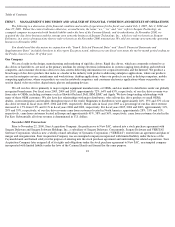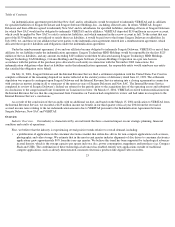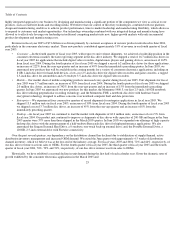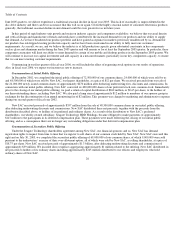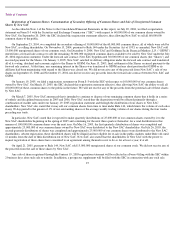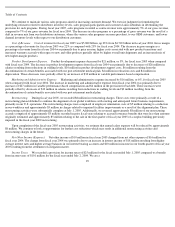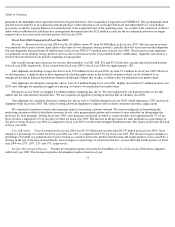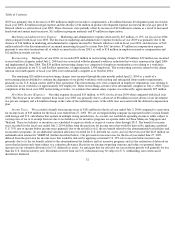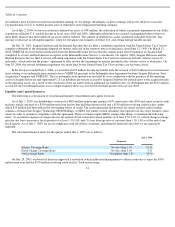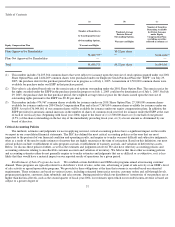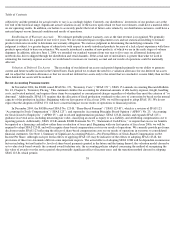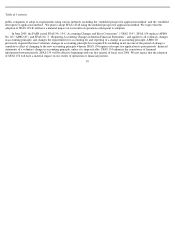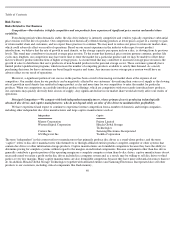Seagate 2004 Annual Report Download - page 33
Download and view the complete annual report
Please find page 33 of the 2004 Seagate annual report below. You can navigate through the pages in the report by either clicking on the pages listed below, or by using the keyword search tool below to find specific information within the annual report.
Table of Contents
foreign holding company incorporated in the Cayman Islands with foreign and U.S. subsidiaries that operate in multiple taxing jurisdictions. As
a result, our worldwide operating income is either subject to varying rates of tax or is exempt from tax due to tax holidays or tax incentive
programs we operate under in China, Malaysia, Singapore and Thailand. These tax holidays or incentives are scheduled to expire in whole or in
part at various dates through 2015. Our provision for income taxes recorded for the fiscal year ended July 1, 2005 differs from the provision for
income taxes that would be derived by applying a notional U.S. 35% rate to income before income taxes primarily due to the net effect of (i)
the tax benefit related to the aforementioned tax holidays and tax incentive programs, (ii) an increase in our valuation allowance for certain
foreign deferred tax assets, (iii) a tax benefit related to a reduction in previously accrued foreign income taxes and (iv) utilization of U.S.
research tax credits generated in the current year. Our provision for income taxes for the fiscal year ended July 2, 2004 differed from the
provision for income taxes that would be derived by applying a notional U.S. 35% rate to income before income taxes primarily due to (i) the
tax benefit related to the aforementioned tax holidays and tax incentive programs, (ii) an additional valuation allowance recorded for U.S.
deferred tax assets, and (iii) the reversal of the $125 million tax indemnification amount for VERITAS (further described below). Based on our
foreign ownership structure and subject to (i) potential future increases in our valuation allowance for U.S. deferred tax assets, and (ii)
limitations imposed by Internal Revenue Code Section 382 on usage of certain tax attributes (further described below), we anticipate that our
effective tax rate in future periods will generally be less than the U.S. federal statutory rate. Dividend distributions received from our U.S.
subsidiaries may be subject to U.S. withholding taxes when and if distributed. Deferred tax liabilities have not been recorded on unremitted
earnings of our foreign subsidiaries, as these earnings will not be subject to tax in the Cayman Islands or to U.S. federal income taxes if
remitted to our foreign parent holding company.
As of July 1, 2005, we have recorded net deferred tax assets of $47 million, the realization of which is primarily dependent on our ability
to generate sufficient U.S. and certain foreign taxable income in fiscal years 2006 and 2007. Although realization is not assured, we believe that
it is more likely than not that these deferred tax assets will be realized. The amount of deferred tax assets considered realizable, however, may
increase or decrease in subsequent quarters, when we reevaluate our estimates of future U.S. and certain foreign taxable income.
On January 3, 2005, we underwent a change in ownership within the meaning of Section 382 of the Internal Revenue Code (IRC Sec.
382) due to the sale of additional common shares to the public by our largest shareholder, New SAC. As a result, our pre-change net operating
losses and tax credit carryforwards are subject to an annual limitation based upon (i) the aggregate fair market value of our U.S. business
operations immediately before the ownership change multiplied by (ii) the federal long-term tax exempt rate (within the meaning of IRC Sec.
382(f)) in effect at that time. Based upon an independent valuation as of January 3, 2005, the annual limitation is $44.8 million. This annual
limitation is cumulative. Therefore, if not fully utilized in a year, it is carried forward for utilization in future years in addition to the IRC Sec.
382 limitation for those years. To the extent we believe it is more likely than not that deferred tax assets consisting of the pre-change net
operating losses and tax credit carryforwards will not be realized, a valuation allowance has been provided. The impact of the IRC Sec. 382
limitation was to increase our current tax expense related to the tax benefit of stock options credited to shareholders equity by approximately
$15 million during the current fiscal year. In future years, such limitation may cause certain pre-change net operating loss and tax credit
carryforwards to expire before utilization. As of July 1, 2005, $409 million of U.S. net operating loss carryforwards and $123 million of U.S.
tax credit carryforwards were subject to the Sec. 382 limitation. In fiscal year 2006, as a result of this change in control, we expect our income
tax rate to increase.
The Internal Revenue Service is currently examining our federal income tax returns for fiscal years ending in 2001 and 2002. The timing
of the settlement of these examinations is uncertain. We believe that adequate amounts of tax have been provided for any final assessments that
may result.
In the fiscal year ended July 2, 2004, we recorded a $125 million income tax benefit from the reversal of $125 million of accrued income
taxes relating to tax indemnification amounts due to VERITAS
30



